#offshore tank
Text
10ft Cryogenic Offshore Tank
10ft Cryogenic Offshore Tank is a container-style tank used for storing liquefied gases (such as liquid nitrogen, liquid oxygen, etc.) and is typically utilized in offshore oil and gas platforms or vessels.
These tanks are engineered with thermal insulation capabilities to facilitate the storage of cryogenic fluids at ultra-low temperatures, thereby guaranteeing their maintenance in a liquid phase.
The tanks are usually built in a standard 10-foot size, making them convenient for various transportation and storage applications. Cryogenic Offshore Tank is suitable for use on offshore oil and gas platforms or vessels where space is limited, offering a compact and reliable solution for storing cryogenic substances.
DSW offers solutions for nitrogen, oxygen, LNG, argon, methane, nitrous oxide, ethylenecarbon dioxide, and hydrogen. The 10', 20', and 40' intermodal containers are typically built according to EN, ASME/DOT, or Chinesedesign standards. Available maximum allowable working pressure (MAWP) options include 10, 18, and 24bars for European designs and 100, 150, 180, and 230 psi for ASME/DOT designs.
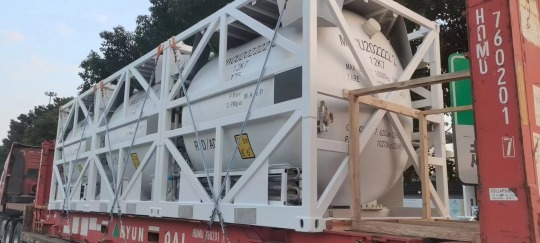
1 note
·
View note
Text
Coating Application Techniques
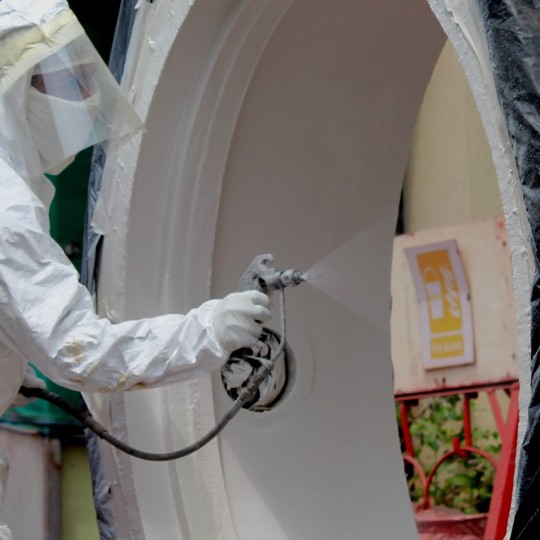
Applying Coating Correctly:
Successful application of protective coatings is pivotal to ensuring infrastructures receiving coatings withstand potential corrosion. There are several detrimental factors to consider if the coating is applied incorrectly and corrosion does occur. Some factors may include:
Bodily harm including irritation and respiratory damage
Loss of production with machinery being inoperable
Financial strain with replacements or repairs
Adverse incidents in public locations
Loss in revenue with downtime
Spray Techniques:
Hand- Striping
An important first step when applying a coating correctly is hand-striping. Before the first general coat is applied it is recommended to complete an extra spray pass or stripe coat. This coats all edges, corners, joints, and other irregular surfaces to ensure all surfaces are ready for the first coat and an adequate film can develop.
Cross-layer application
Applicators often spray coatings with a horizontal pass first which unfortunately can lead to a series of issues that may have a detrimental effect on the coating’s performance and service life. By beginning with a horizontal application, a dry edge can eventuate in the bottom of the spray pattern and from there gravity will drag the liquid film causing an over thickness which can sag and run. To avoid this, it is essential the vertical passes of the spray gun are used first followed by horizontal passes, creating a cross-layer application.
Why is it important to apply a vertical pass first?
Beginning with a vertical pass avoids a defined edge which a horizontal pass can cause. Increasing the stability of the coating, vertical application technique also aids in the uniform thickness of the applied film across a large area.
To maximise mechanical adhesion and encourage optimum surface coverage, the distance of the spray gun to the surface is extended to approximately 24 to 36 inches to avoid an orange peel appearance and give more even coverage.
Corners and Edges
Another critical aspect of spraying technique is the correct approach to spraying corners and edges. When coating a corner or edge, particularly one with a small radius, the natural phenomenon of the paint is to retract due to surface tension this can be exacerbated by incorrect application techniques. If the applicator simply sprays each face and does not treat the corner, the edge will not be protected, and corrosion will occur more rapidly.
Atomisation
Paints and coatings must be atomised satisfactorily to facilitate homogeneous and uniform coverage. When atomisation is not correct, the materials ability to coalesce will be compromised and the coating may have a textured finish similar to that of orange peel. This effect may have an impact on the coatings performance in its intended service.
Thickness testing
Ensuring the thickness of the anti-corrosion coating has been correctly applied is vital to the success or failure of the product. Corrocoat offers inspection services to ensure quality assurance and standards have been met. We perform a thickness test using a coating thickness gauge.
Conclusion:
The application of protective coatings can greatly affect whether infrastructures are protected against corrosion. Correct techniques are a simple solution to ensuring the successful outcome of anti-corrosion coatings. At Kirloskar Corrocoat, all our products are applied within stringent standards, and everything we coat with our Kirloskar Corrocoat product range is returned with a quality assurance certificate.
#Offshore Coating#Absorber Internal Coating#Pump Internal Coating#Water Box Coating#Tube Sheet Coating#Tank Internal Coating
0 notes
Text
TOTE TANK SPECIALIST
TOTE TANKS
LAVA Engineering Company has been manufacturing Offshore / Onshore Tote Tanks for many years now. Client from Oil & gas Industry, chemical Industry, Logistics prefer LAVA TOTE TANKS for Marine transport and as off-shore containers. LAVA Tote tanks are also used as storage tanks, process tanks and Industrial containers for chemical industries, Oil drilling companies, Pharmaceutical companies and others. KNOW MORE
LAVA, Tote tanks manufacturer India, supplies high quality tanks with precision and meets Intermediate Bulk Container standards with capacities ranging from 300 Gallons, 550 Gallons and 1000 Gallons in SS 304 and SS 316L MOC to suit client requirement and applications.
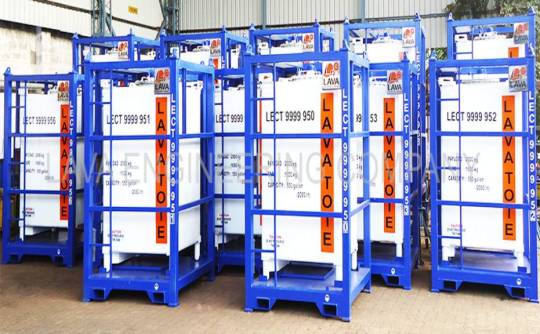
LAVA TOTE Models - DOT - UN 31 A ( DNV 2.7.1 Certified With TOTE Frame)
300 Gallons - 42" X 48" X 45" Size - 200 Kgs
550 Gallons - 42" X 48" X 72" Size - 295 Kgs
793 Gallons - 54" X 54" X 77" Size - 475 Kgs
Accessories Of LAVA TOTE TANK
Filling, Discharge, Drain, Pad Eyes ( as per DNV / EN), Document Holder, Fork lift provision and bottom Support Legs.
0 notes
Text
"China is on track to double its wind and solar energy capacity and hit its 2030 clean energy targets five years early, a new report has found.
The country is expected to produce 1,200 gigwatts of solar and wind power by 2025 if all prospective plants are built and commissioned, according to the study from the non profit Global Energy Monitor.
Solar capacity in China is now greater than the rest of the world combined. Its onshore and offshore wind capacity has doubled since 2017, and is roughly equal to the combined total of the other top seven countries, according to the report.
Dorothy Mei, project manager at Global Energy Monitor, said China’s surge in solar and wind capacity was “jaw-dropping.”
The country’s renewable energy boom is the result of a combination of incentives and regulations, according to the report. China pledged in 2020 to become carbon neutral by 2060...
China’s reliance on coal poses a significant challenge to global green energy targets, but the pace of wind and solar development is a positive sign, Byford Tsang, senior policy adviser at climate think tank E3G told CNN.
“China is rapidly and successfully scaling up its deployment of renewable power and has become the largest investor into renewables globally. This is both a cause and consequence of rapidly falling costs of renewable energy as compared to coal power,” he said.
Tsang hopes that relative cheapness of renewable energy will persuade China to kick its coal habit."
-via CNN, June 29, 2023
#china#fossil fuels#climate crisis#climate change#sustainability#carbon emissions#solar power#wind power#coal#good news#hope
1K notes
·
View notes
Note
Hiya! Would you be willing to explain why keeping captive right whales is completely nonviable, as you mentioned? I’m fascinated, but the adhd simply will not let me parse scientific papers.
That's a fantastic question! While it would be wonderful if captive breeding were a viable option for this critically endangered species, it just isn't possible under any realistic conditions.
For starters, their size. Orcas are the largest mammals successfully held in captivity, and we all know how difficult (and controversial) that is, with only a very small handful of facilities ever pulling it off with any semblance of success. Tilikum, the largest captive orca (although I believe that record has since been overtaken by a male in China), was 22.5 feet (6.9 meters) long and weighed 12,500 pounds (5,700 kg). Most other orcas in human care, particularly the females, are considerably smaller. Compare that to a northern right whale. Even the smallest adults are over 40 feet long—double Tilikum's length—and weigh 88,000 pounds (40,000 kg)—seven times his weight—while the biggest specimens on record reached up to 61 feet (18.5 m) and an incredible 234,000 pounds (106,000 kg).
A tank for an animal that size would be far beyond anything we have the ability to engineer and maintain. Think of how deep it would have to be for the whale to even turn around! The water pressure would be astronomical, wreaking havoc on the building materials even if it were possible to build the structure. And remember—someone has to dive to clean it! Our theoretical right whale habitat would have to be a sea pen, but even the 100-acre facilities proposed with orcas in mind are nowhere near deep enough. While right whales are considered to inhabit "coastal" waters, they do not live right up by the shoreline, like certain orca ecotypes and other small delphinids. They are a pelagic species, designed to live out in the open water column, as are all baleen whales. So, the pen would have to be a floating habitat miles out into the open water (think of an offshore oil rig), with netting sturdy enough to not be destroyed by a 50 ton whale and long enough to extend hundreds of feet to the ocean floor. We're talking probably thousands of square miles of netting, that would have to be routinely inspected for safety and upkeep. So, you would probably need a submersible, since no human can dive that deep. On top of that, it would be difficult to find such a larger stretch of ocean in their habitat without shipping lanes, underwater noise, or pollution. And let's just forget about the logistics of staffing that place—or worse, funding.
Additionally, we wouldn't be able to feed them by tossing fish into their mouth like with dolphins. Northern right whales feed on tiny crustaceans and zooplankton, cruising along and filtering the creatures from the water with their baleen. Assuming our right whale keepers were somehow able to acquire the insane amount of food the whale requires (potentially over 5000 pounds of zooplankton a day), it would need to be scattered throughout the massive habitat to facilitate feeding. I imagine this would probably look something like the way Georgia Aquarium feeds their whale sharks from a little boat, although on a much larger scale. And since the food obviously can't be kept alive, we would need to develop someway of delivering the daily vitamins that are lost in the freezing process—and to keep hundreds of tons of krill frozen on a floating kitchen in the middle of the ocean.
Of course, the ultimate goal of this project would be to breed northern right whales... that means we need to take everything we just talked about and double it, at a bare minimum. For the breeding program to be successful, it would need a whole lot more than just two whales. And unfortunately, even if we lived in world with magical floating thousand-acre sea pens, unlimited krill, and endless money... we still don't know if it would even work. Right whale breeding habits are poorly understood, with the whales mating in cold northern waters before migrating 1,000 miles south to calve. Despite our best theoretical efforts, these migratory patterns could very well be necessary for successful reproduction.
Thank you again for the ask! This was actually a lot of fun to think about! If you want to read about JJ, the only baleen whale ever successfully housed in (temporary) human care, you can find an article and pictures here.
#still working through my inbox#the frequency at which I answer will slow down now that I'm back on clinics#northern right whale#baleen whales#cetaceans#marine mammals#conservation#answered asks#funlovingfuzzball
44 notes
·
View notes
Text
🔅ISRAEL REALTIME - Connecting the World to Israel in Realtime
🔻HEZBOLLAH - Anti-Tank Missile(s) - at Margaliot - HIT, 3 farm workers injured.
🔻HEZBOLLAH - Suicide Drones - Beit Hillel, Kfar Yuval, Gonen and many surrounding towns.
▪️HOSTAGE / CEASEFIRE NEGOTIATIONS.. A senior Hamas official who is in Cairo told the Wall Street Journal: "The first week of Ramadan - a realistic target for a deal”.
And a new demand: A report on the Saudi Al-Arabiya channel: Hamas handed the "keys" to the mediators to release the prisoners in exchange for the Israeli hostages. Hamas demands the return of 500 families to the northern Gaza Strip every day of the ceasefire.
▪️GAZA.. Sources in Gaza report that athis morning our forces destroyed several high-rise buildings in the city of Khan Yunis. According to reports - the explosion was also heard throughout the south of the country.
▪️JORDAN.. Jordan is asking for an increased water allocation (Israel provides them a significant amount of water from the Kinneret) after trashing the Israelis for nearly 5 months and downplaying the Oct. 7 massacre - along with arranging threatening along-the-border night exercises of their military.
▪️COUNTER-TERROR BATTLES.. Fatah terrorists shot at security forces this morning in the al-Amri camp near Ramallah, with one of our forces shot and injured. In response the IDF had large forces enter the El Omari camp near Ramallah, the Arabs report at least one terrorist killed.
Tulkarm - IED road mine damaged an armored carrier (a panther).
Tubas - terrorists opened fire from a building at our forces. The building was charged, the force identified the source of the shooting and an exchange of fire began. No casualties.
Shechem - the Shin Bet and the Israel Defense Forces operated tonight in Nablus and destroyed the house of one of the terrorists who carried out the attack in which the members of the Dee family were murdered.
▪️RED SEA - WORLD INTERNET CABLES CUT.. HGC Communications reports 4 of 15 undersea cables in the Red Sea have been cut - reducing their communications by 25%.
▪️RED SEA - GERMAN NAVY SHIP EXPLOSION.. apparently (from grainy video - if real) a failed counter-missile launch that exploded in the tube.
▪️RED SEA - UK SAYS.. The British Embassy in Yemen announced in a statement: The responsibility for the environmental effects caused by the sinking of the ship "MV Rubymar" in the Red Sea lies with the Houthis, and despite international efforts, today the ship "MV Rubymar" has sunk and 41 thousand tons of ammonium phosphate fertilizer and its fuel will leak into the Red Sea.
▪️AID DROP MISS.. Gazans show videos of aid drop misses into the sea, a few close and some a significant distance offshore.
19 notes
·
View notes
Text

FAR OUT AT SEA
"Shiro is determined to know if the new human research base is a risk for his fellow merfolk with the help of a marine biologist and research intern Adam."
rating: T
pairing: Adam/Shiro
tags: Adam (Voltron) Shiro (Voltron), Keith for half a line but he is there, Merman Shiro, Everyone lives, First Meetings, plot-driven action, Alternate Universe Merpeople, Canon-Typical Violence
This fic is part of the Once Upon the Seashore PDF (get it for free on my Ko-fi)
Chapter 1 of 4
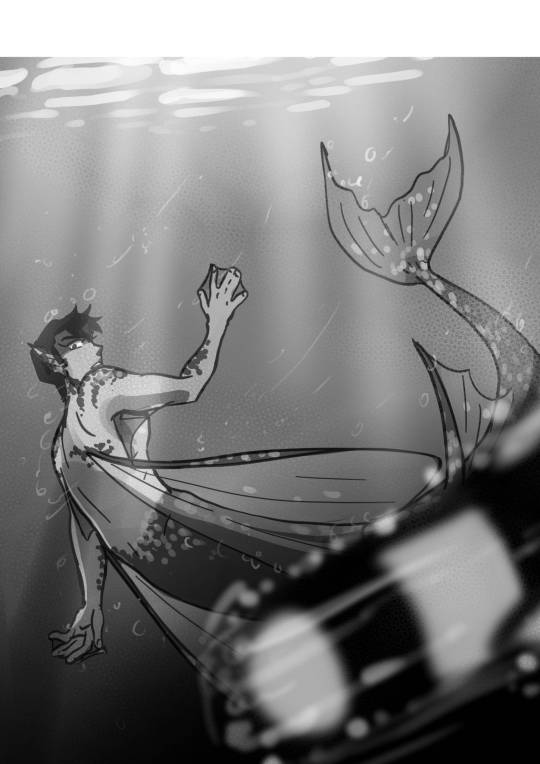
Shiro made it his mission in life to see it all. He swam beyond the limits of his people's realm, he defied the currents that made all other merfolk hold onto coral reefs and quiver. He rose to the surface many times and walked the earth, mingling with humans as he pleased and going back to his home unharmed. Afraid of nothing, he ventured everywhere under and above the sea, infinitely curious and confident.
He was so used to going out looking danger in the eye that he never expected it to bite him back.
This time, the UUV (Unmanned underwater vehicles) that suddenly appeared deep in the open sea was not the first Shiro had seen, but it was definitely the most advanced. Its engines were so quiet that he didn’t notice the noise until the artifact was dangerously close. What was that thing doing, roaming merfolk territory? For the safety of his people, Shiro had to find out. He was also intrigued by such a sophisticated trinket that was able to go great depths, yes, but that was secondary.
Concealing himself in the dark waters, Shiro followed the underwater drone around. It took samples of algae, plankton, and whatever else crossed its path, it took photographs and emitted low noises, maybe mapping the topography of the area. After a while, it backtracked and led Shiro to a big building constructed in the middle of the ocean, much like the offshore oil rigs but this one was different, it was a newly and highly militarized scientific base. Shiro's suspicion grew stronger. He had to know what exactly was going on there and determine whether it was dangerous.
It wasn’t his first time on a recon mission, with one stolen uniform and one forged pass later, he infiltrated the base posing as yet another young recently scouted intern and began his investigation. He found all kinds of fish living in tanks of different sizes, many measuring instruments he had never seen before, and endless fridges stuffed with samples of everything under the sun, but fortunately, nothing that belonged to merfolk. It all seemed harmless so far, but still, a little more time could uncover any real danger like military bases always provided to anything underwater, so Shiro decided to stay a bit longer.
If he was going to infiltrate for a little more time, Shiro thought it convenient to have an unsuspecting human to ask about the details of the operations there. And was like this, that during a boring afternoon of classifying old files, he found an actual intern, a young man called Adam, who offered him a smile when Shiro presented himself as Takashi.
While Shiro found most people on the base dull at best, Adam quickly grew on him. He was clever, genuinely passionate about marine life, and didn't pretend that being what amounted to an errand boy was any kind of honor or enjoyable activity, something that Shiro could appreciate.
— o –
Speaking with Adam, Shiro confirmed some of his suspicions and learned new information. The base was a military facility dedicated to research, currently focused on finding new materials on the oceanic soil. Most specialists were engineers and geologists; as far as Adam knew, They were one of only five biologists in the whole place. He was deeply unhappy about the official's lack of interest in marine biology, given that they had collected a huge amount of specimens anyway. It was endearing hearing Adam theorize about the next sea sponge they could discover with that kind of equipment. Shiro wouldn’t worry if most humans were like him, if Adam would believe him if he told him his real motives in the base, or if Adam would mind what he actually is…
“You see Takashi? They only care about their little power struggles and their weapons,” Adam lamented one day during their lunch break, “such a waste! Honestly, if this experience wasn't key for the kind of scholarship at the marine institute I want to go to, I'd have packed my bags months ago.”
“There's nothing else here besides that scholarship, then?” Shiro asked while playing with his food, “You didn’t find anything you like here at all?”
Adam eyed Shiro, apparently pondering something. Shiro held his gaze with amusement, which ended up making Adam smile.
“I admit I enjoy some company, yeah,” he finally confessed and looked elsewhere before clearing his throat, “I mean…”
It was so obvious Shiro had to laugh. He was very clear in his in-and-out mission to uncover the secrets of this specific research facility and then return to the open sea with the necessary information to protect his people, but spending one or two weeks more in the base just so he could have these lunch dates with Adam was not too bad. Not at all.
----
Far Out at Sea is complete on PDF >> GET IT HERE <<
#ADASHI#VOLTRON#voltron legendary defender#fanfic#i like having everything here on tumblr#makes it feel organized
73 notes
·
View notes
Text
Preserving Assets: The Role of Corrosion Inhibitors in Industrial Maintenance
Corrosion is a persistent threat to industrial assets, causing billions of dollars in damages annually across various sectors. From oil and gas facilities to manufacturing plants, the impact of corrosion can be devastating, leading to equipment failures, production downtime, and costly repairs. However, with the right preventive measures in place, such as corrosion inhibitors, industrial facilities can effectively mitigate the risk of corrosion and prolong the lifespan of their assets. As a leading chemical company in Vadodara, Imperial Oilfield Chemicals Pvt. Ltd. (ICPL) understands the critical role of corrosion inhibitors in industrial maintenance. In this blog post, we'll explore the importance of corrosion inhibitors, their applications, and the expertise of ICPL as a corrosion inhibitor manufacturer and exporter in India.

Understanding Corrosion Inhibitors
Corrosion inhibitors are chemical compounds designed to protect metal surfaces from the damaging effects of corrosion. By forming a protective barrier on the metal surface or altering the corrosion process, inhibitors prevent or slow down the oxidation and deterioration of metals in corrosive environments. Corrosion inhibitors are widely used in various industries, including oil and gas, petrochemicals, power generation, water treatment, and manufacturing, to safeguard critical assets and infrastructure from corrosion-related failures.
The Importance of Corrosion Inhibitors in Industrial Maintenance
1. Asset Protection: Industrial facilities rely heavily on equipment and infrastructure made of metal, such as pipelines, tanks, vessels, and machinery. Corrosion inhibitors play a crucial role in protecting these assets from corrosion, extending their service life and reducing the need for frequent repairs or replacements.
2. Cost Savings: Corrosion-related failures can result in significant financial losses due to equipment downtime, production disruptions, and repair expenses. By incorporating corrosion inhibitors into maintenance programs, industries can minimize the risk of corrosion-related failures and realize substantial cost savings in the long run.
3. Safety and Reliability: Corrosion compromises the structural integrity of industrial assets, posing safety hazards to personnel and the surrounding environment. Corrosion inhibitors help maintain the reliability and safety of critical infrastructure, reducing the likelihood of accidents, spills, and environmental contamination.
4. Environmental Protection: Corrosion-related leaks and spills can have detrimental environmental consequences, polluting soil, water bodies, and ecosystems. By preventing corrosion and minimizing the risk of leaks and spills, corrosion inhibitors contribute to environmental protection and sustainability efforts.
Applications of Corrosion Inhibitors
Corrosion inhibitors find applications across various industrial sectors, where metal components are exposed to corrosive environments. Some common applications of corrosion inhibitors include:
Oil and Gas Production: In the oil and gas industry, corrosion inhibitors are used to protect pipelines, well casings, and production equipment from corrosion caused by corrosive fluids, gases, and environmental conditions.
Water Treatment: Corrosion inhibitors are added to cooling water systems, boilers, and wastewater treatment facilities to prevent metal corrosion caused by dissolved oxygen, scale formation, and aggressive ions.
Manufacturing: In manufacturing processes involving metal components, such as automotive, aerospace, and electronics manufacturing, corrosion inhibitors are used to protect parts, components, and machinery from corrosion during production, storage, and transportation.
Marine and Offshore Structures: Corrosion inhibitors are applied to marine vessels, offshore platforms, and coastal structures to protect against corrosion in seawater environments.
ICPL: Your Trusted Corrosion Inhibitor Manufacturer and Exporter in India
As the best chemical company in Vadodara, ICPL is dedicated to delivering high-quality corrosion inhibitors tailored to the specific needs of industrial clients. Here's why ICPL is the preferred choice for corrosion inhibitors in India:
Expertise and Experience: With decades of experience in the chemical industry, ICPL possesses the expertise and technical know-how to develop and manufacture corrosion inhibitors that meet the highest quality standards and regulatory requirements.
State-of-the-Art Facilities: ICPL operates state-of-the-art manufacturing facilities equipped with advanced technologies and production processes to ensure the consistent quality and performance of its corrosion inhibitors.
Customized Solutions: ICPL offers customized corrosion inhibitor formulations tailored to the unique requirements and operating conditions of industrial applications. Our team of experts works closely with clients to develop solutions that address specific corrosion challenges and performance objectives.
Global Reach: As a corrosion inhibitor exporter in India, ICPL serves clients worldwide, exporting its products to diverse markets across Asia, Africa, the Middle East, and beyond. With a strong global presence and distribution network, ICPL delivers reliable corrosion protection solutions to industries around the globe.
Conclusion
In conclusion, corrosion inhibitors play a crucial role in industrial maintenance by protecting metal assets from the damaging effects of corrosion. As a leading corrosion inhibitor manufacturer and exporter in India, ICPL is committed to providing high-quality corrosion inhibitors that safeguard critical infrastructure, ensure operational reliability, and promote cost-effective maintenance practices. With ICPL's expertise, customized solutions, and global reach, industries can effectively mitigate the risk of corrosion and preserve the integrity of their assets for years to come. Contact ICPL today to learn more about our corrosion inhibitor products and solutions.
#Corrosion inhibitor Vadodara#Best chemical company in Vadodara#Corrosion Inhibitor exporter in India#Corrosion inhibitors manufacturer in India#Oxygen scavenger Chemical in Vadodara#Oxygen scavenger Chemical supplier in Gujarat#Oxygen scavenger Chemical Manufacture India#Oxygen scavenger Chemical exporter in Gujarat#Oil and gas industry#Oil and gas companies#Oil and gas pipelines#leading Oilfield Chemicals manufacturer and exporter in India
7 notes
·
View notes
Text
Fallout: Ocean Song ~ Lore Crafting
I have a pinboard folder of inspiration for Fallout: Ocean Song, the original podcast idea I had to create an entire story on the oceans as opposed to land...somewhere we've never gone before in the games.
I've been thinking about floating offshore supercities that just before the Great War became independent nations for scientists and anti-war think tanks. Post war they were easily conquered by raider pirates...
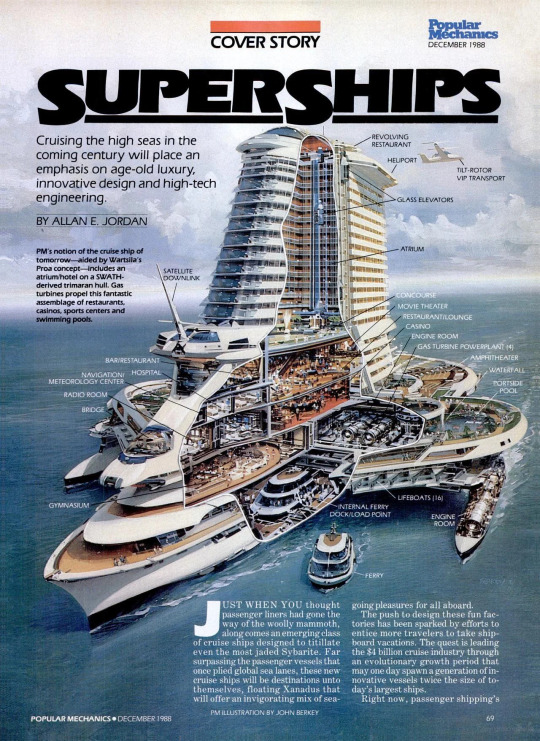
As raiders are to the land of the ruined Old World, so are pirates to the sea. Scenic coastal villages once teeming with tourists, are now havens for a new generation of raiders. Centuries after they were hunted to the last, the old flags of piracy fly again.
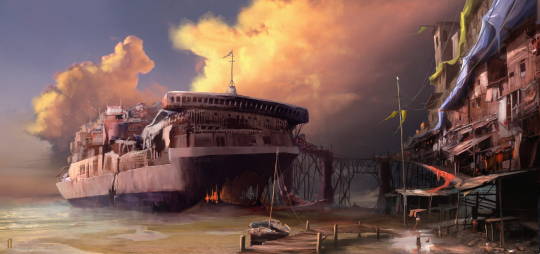
#chad: a fallout 76 podcast#fallout 4#chad: a fallout 76 story#Fallout: Ocean Song#fallout ocean song#fallout podcast#chad fallout 76 podcast#podcast
32 notes
·
View notes
Text
When turbine blades for the United States’ first offshore wind project left port in September 2023, headed for the Vineyard Wind 1 project off Massachusetts, they were traveling on a barge instead of a wind turbine installation vessel, or WTIV. These purpose-built vessels are common in other parts of the world and make the job much, much easier. A WTIV is a transportation and construction rig in one. Frequently equipped with a big crane, deployable legs, and a dynamic positioning system, WTIVs can support the installation of several humongous turbines per trip.
There are dozens of WTIVs plying the world’s waters. So, why were the Vineyard Wind 1 blades delivered on a barge? This expensive, inefficient workaround was necessary because of a century-old law known as the Jones Act.
Also known as the Merchant Marine Act of 1920, the Jones Act requires anyone transporting goods from one point in the United States to another to use an American ship. And by a modern interpretation of the old law, an offshore turbine counts as a point in the United States. The trouble is, the United States doesn’t have any WTIVs. And without the appropriate equipment, the country’s offshore wind efforts are being plagued by the need for repeated, smaller-capacity barge trips that have added costs to projects already beset by financial difficulties. Danish energy company Ørsted, for example, cited vessel delays when it canceled two planned projects off the New Jersey coast: Ocean Wind 1 and 2.
The country’s first Jones Act–compliant WTIV, the Charybdis, is currently under construction in Texas. While originally planned for completion in 2023, labor constraints have pushed the Charybdis’s launch back at least a year, possibly into 2025, says Dominion Energy, the vessel’s owner.
The Biden administration’s goal is to deploy offshore wind turbines capable of generating 30 gigawatts of power by 2030. That’s more than 2,000 turbines. To meet this target, the National Renewable Energy Laboratory (NREL), part of the US Department of Energy, says there’s a need for four to six WTIVs. But as 2030 draws ever closer, the incomplete Charybdis remains the only one.
The Jones Act is tricky to navigate. For a vessel to be compliant, it must not only be built in the United States and running the country’s flag but also be owned and crewed by Americans. Consequently, US shipyards enjoy a monopoly, which allows them to demand massively inflated prices.
When finished, the 144-meter-long Charybdis will boast over 5,000 square meters of main deck area and accommodate up to 119 people, supported by on-board cabins, mess rooms, and shops, as well as a cinema, gym, and hospital. But the WTIV’s cost has climbed from US $500 million to $625 million. Meanwhile, the major shipyards in South Korea could have built a similar vessel in less time, for less money, and with a more powerful crane.
The reason for the Jones Act’s longevity, says Colin Grabow, a research fellow at the Cato Institute, a libertarian think tank, is that while it tends to benefit only a few people and businesses, the act goes unnoticed because there are many payers sharing the increased costs.
The Jones Act is one in a string of protectionist laws—dating back to the Tariff Act of 1789—designed to bolster US marine industries. The Jones Act’s existence was meant to ensure a ready supply of ships and mariners in case of war. Its authors reasoned that protection from foreign competition would foster that.
“Your average American has no idea that the Jones Act even exists,” Grabow says. “It’s not life-changing for very many people,” he adds. But “all Americans are hurt by the Jones Act.” In this case, that’s by slowing down the United States’ ability to hit its own wind power targets.
Grabow says those most vocal about the law—the people who build, operate, or serve on compliant ships—usually want to keep it in place.
Of course, there’s more going on with the country’s slow rollout of offshore wind power than just a century-old shipping law. It took a slew of factors to sink New Jersey’s planned Ocean Wind installations, says Abraham Silverman, an expert on renewable energy at Columbia University in New York.
Ultimately, says Silverman, rising interest rates, inflation, and other macroeconomic factors caught New Jersey’s projects at their most vulnerable stage, inflating the construction costs after Ørsted had already locked in its financing.
Despite the setbacks, the potential for offshore wind power generation in the United States is massive. The NREL estimates that fixed-bottom offshore wind farms in the country could theoretically generate some 1,500 gigawatts of power—more than the United States is capable of generating today.
There’s a lot the United States can do to make its expansion into offshore wind more efficient. And that’s where the focus needs to be right now, says Matthew Shields, an engineer at NREL specializing in the economics and technology of wind energy.
“Whether we build 15 or 20 or 25 gigawatts of offshore wind by 2030, that probably doesn’t move the needle that much from a climate perspective,” says Shields. But if building those first few turbines sets the country up to then build 100 or 200 gigawatts of offshore wind capacity by 2050, he says, then that makes a difference. “If we have ironed out all these issues and we feel good about our sustainable development moving forward, to me, I think that’s a real win.”
But today, some of the offshore wind industry’s issues stem, inescapably, from the Jones Act. Those inefficiencies mean lost dollars and, perhaps more importantly in the rush toward carbon neutrality, lost time.
6 notes
·
View notes
Text
Scumplane Pacific rim AU pt 3
[Pt. 1] [Pt. 2]
More action heavy this chapter.
Oh for the love of- Curse Shang Qinghua’s stupid rotten luck!
It should have been an easy fight - the initial breach was only a Category 3. Well, if not an easy fight at least a straightforward one. That was, until the beast had breached the surface and they’d gotten a visual. By then Cheng Luan had already been in the process of deploying and there was no time for a change in tactics. Liu Qingge headed their most seasoned pilot pair, even if the second half of the set was a revolving door of faces from Bai Zhan, Cheng Luan would come through this no problem. Then the giant shell on the beast’s back lifted to reveal leathery wings and the beast was airborne making a beeline for the coast just five miles north of the dome. The intercept was already in motion, they’d have plenty of time.
Except- whatever had designed these terrible beasties must have been on a bug kick when they’d pieced this one together. Its bloated and bulbous belly writhed as Cheng Luan was dropped and sped toward its opponent with singular focus. Jaeger and Kaiju circled in a lethal dance as Cheng Luan kept the beast, now nicknamed Taotie in the Com-Room, from reaching shore. Taotie bellowed as it swooped toward Cheng Luan with clawed forelimbs extended. Meeting blow for blow, Cheng Luan arced its primary blade up in a sweep calculated to bisect the creature. The blade nicked Taotie’s belly and came into a guard just as the full weight of the creature’s scrabbling limbs locked around the Jaeger, pincer jaws extended toward the conn pod. Amid the tussle, Taotie's belly gave way with a sickening pop and wave of Kaiju Blue. It hadn't been a belly at all but a sac wrapped around the creature's tail and several dark masses. The weight shifted as the clumps fell into the water below. Taotie's wickedly curved tail arched over its back. Overbalanced, Cheng Luan began to tip backwards and spun in the descent to pin Taotie beneath it. Command started to receive visuals on the clumps that had separated and now a small fleet of unidentified foes were a mere mile offshore.
This was bad. This was very very bad. Xian Shu's pair were still laid up in the infirmary after the last attack. Ku Xing's Jaeger was still grounded for repairs to contain and stabilize the radiation leaking from its reactor. Watching the situation unfold from the Command Deck, Shang Qinghua mentally blazed through the list of candidates. Thanks to the increasing rates of breaches they were down to Xuan Su or Xiu Ya and Yue Qingyuan was needed on the deck. That just left - No. Absolutely not. It was still too soon to send Shen Qingqiu out again, he'd just been released from Mu Qingfan's care a week ago from a fight a -month- ago. In a daze, Shang Qinghua looked back at the display broadcasting the battle. His heart plummeted to his stomach. Cheng Luan was holding its own for now but the battle wasn't in their favor. The fight had made landfall in a normally bustling part of the city. If luck was in their favor, which Shang Qinghua had some serious doubts about at this point, Liu Qingge had kept the Kaiju busy enough to allow for most to evacuate. Judging from the hard looks on faces around the Comm Room, it hadn't been enough. Taotie had latched onto Cheng Luan's back and its scorpion-like tail pierced the Jaeger's midsection like a hot knife through butter. By no means ideal but Shang Qinghua had seen Liu Qingge and co-pilot by extension come through worse, maybe it would be okay.
It was not going to be okay. The masses carried through the breach by Taotie had been roughly man-sized when they disengaged. By the time they made landfall they were the size of tanks and getting bigger. When they started dropping from sky scrappers to dogpile onto Cheng Luan, they’d reached the size of semi trucks. Out of the corner of his eye, Shang Qinghua saw Yue Qingyuan’s expression shift from concern to the closest thing he’d seen to terror on the Marshall’s face and a quick shake of Yue Qingyuan’s head. Shang Qinghua whipped around to follow Yue Qingyuan’s line of sight and caught a glimpse of one of Shen Jiu’s signature suits speeding out the door. Shit. Shit shit shit.
—
Even knowing it was an ill-fated plan, Shen Qingqiu had always believed in the capability of the dome beyond himself. So he went. The couplers from the airlift disengaged and Shen Qingqiu braced for the transition from free fall to a run. Cheng Luan had managed to disengage from the dog pile but was badly damaged by the time Xiu Yu reached the front line of the battle. The Jaeger’s right side was lodged in a building and most of the cabling connecting upper and lower body were severed. Cheng Luan's left arm lay somewhere under the rubble across the road.
“Shen Qingqiu,” Liu Qingge rasped before falling silent.
Even barely conscious, the man couldn’t stand him. Evac was still more than fifteen minutes out. Take down the beasts or distract them long enough for Liu Qingge and disciple to be secured. It was a simple plan and an efficient one, open to permutations as the situation required. The rattled hiss was the only warning Shen Qingqiu got before the kaiju’s maw shot out from the darkness behind Cheng Luan. Acting on instinct, Xiu Ya yanked Cheng Luan forward to step neatly between his brother-in-arms and the oncoming threat. A garbled “rat bastard pretty boy” came through the comms channel as the remaining conscious pilot was jostled. Shen Qingqiu tuned it out as his focus narrowed to the tip of his sword thrusting into the pincered abyss before him. Let Liu Qingge continue to think poorly of him. Just so long as he lived long enough to do so.
With Taotie and company engaged, shifting the battlefield away from the carapace of Cheng Luan was straightforward. However, landing the final blow to dispatch Taotie took more out of Shen Qingqiu than it should have. A blinding headache had begun building behind his eyes making it difficult to focus on the hoard of drones still circling him and there'd been a high pitched ringing in his right ear since he reached the district. Even through the relay gel he could feel sweat gathering at his temples and upper lip. Xiu Ya’s left side wasn’t responding as it should. Too slow, like moving through water. Compensating for the delay was possible but - it was a bad sign. Gods knew Mu Qingfan had drilled the warning signs into him often enough. Still, surrounded by enemies engaging in pack tactics to get the drop on him didn’t leave him with many options.
Mission control was shouting something but the ringing and incessant pounding in his skull made focusing enough to discern it impossible. The words were just an added layer of noise in the cacophony of his pulse and the dying shrieks of his opponents. Unease churned in his gut as the blaring claxons of his mind drowned out any attempt at thought. Unable to think, unable to plan, he would have to rely on muscle memory to push through, nothing existed beyond that.
—
Vitals blipped and streaked across the panels of Qian Cao’s station in the control room, drastic peaks and valleys in the place of the steady wave form that indicated a healthy pilot. They were going to watch Shen Qingqiu stroke out in real time, Shang Qinghua thought dazedly, they were going to watch, just let it happen, and then pretend regret at the funeral as though nothing could be done. Other parts of Control were a hive of activity, organizing additional ground forces to assist evac under the assumption that Shen Qingqiu would die before Cheng Luan and crew could be recovered.
The years of service, of pushing beyond the limits of the possible for even the first percentile of experienced pilots and Cang Qiong was simply going to abandon him. Toss him away like garbage once he was no longer useful. Fuck that. No.
“It’s not right, this isn’t right,” Shang Qinghua’s muttering was lost in the surrounding din. He ran through their options at breakneck speed. He had little to no authority in the Control Room so trying to leverage a support team for Xiu Ya was off the table. Yue Qingyuan seemed…pained but resigned already grieving a man not yet dead. Or maybe grieving what could have been if he had clipped his Xiao Jiu’s wings earlier. No, no, Airplane was getting off track, he needed to focus. Wait - he could fix this. He could definitely probably fix this.
Everyone had long since learned to tune out his ramblings and even his presence unless they needed something so no one batted an eyelash when Shang Qinghua scurried out of the Control Room at a speed faster than his usual scramble.
There was still a PON headset in the lab calibrated and linked to Xiu Ya’s systems from the last set of upgrades two days ago. Two days. His hands were shaking and a thick nausea rose in the back of his throat as he cleared the Command corridor headed full-tilt toward the labs. He could fix this, he could. He just needed time. Time Shen Qingqiu likely didn’t have but the bullheadedness of his scum villain had worked miracles before, Airplane needed it work another one now.
The adrenaline rush already made him feel half out of his body by the time the headset was secured. Shen Jiu was stubborn and spiteful and mean and if Shang Qinghua could establish a link in time, he knew beyond a shadow of a doubt that Shen Qingqiu would pull through. The control board for the headset blinked a steady green. He took a breath to steady himself, mouth pulling in grim determination as he initiated the handshake sequence. The world around him swayed and distorted like he’d been spun too quickly on a carnival ride not quite up to code and his mind spun out with it.
The drift wasn’t what he had expected, not that he’d particularly known what to expect in the first place. It crashed into him like waves, allowing him enough time to try to catch a breath and orient himself only for the next wave to break before he could get enough air. Shang Qinghua did his best to try and relax into it, to let the waves do the work of carrying him into the Bridge. There was no mistaking it when the Bridge formed. Shen Qingqiu’s fury was palpable with Shen Jiu’s shame tucked behind to hide it, a child hiding behind their mother’s skirts.
Nothing was hidden in the drift. Not the brutal past Airplane had written for Shen Qingqiu that twisted and fractured to fit the new narrative, not Shang Qinghua’s identity as a transmigrator turned spy. Shang Qinghua had thought he might panic at being laid so bare, all of his secrets displayed like wares at a swapmeet. Instead, all he could feel was relief. Relief at being seen truly and completely, at being known in a way that words could never convey, being mirrored and refracted should be disconcerting but it felt like part of him. Arguably since Shen Qingqiu had sprung from his mind to the textblock of PIDW, Shen Jiu was part of him. It was more tangible than that though.
And oh, Shen Qingqiu was going to have WORDS with him later, Shang Qinghua could feel that through the drift clear as day. But for now, the Bridge was doing its job, parsing the mental load between them enough for Shen Qingqiu to claw his overtaxed mind back from the edge. Without being in Xiu Ya’s conn pod, Shang Qinghua couldn’t assist with the actual physical piloting. Instead, his mind acted like the bulkheads of a ship, stymieing the flood to keep the vessel afloat.
Now that he wasn’t bearing the full load himself, Shen Qingqiu tore through the remaining kaiju like tissue paper. Piloting had never been this easy, Xiu Ya this responsive. He wove through enemies, sweeping the battlefield like a selective tempest. Minimizing damages to the surrounding district was easier as well, closer to the precise strikes and flows he drilled in the practice rooms than reality of kilotonnes of steel and cabling darting about in a murderous dance. It was euphoric, though that was likely the adrenaline. His quietly jubilant laughter tumbled out of the speakers in Control sending shivers down the spines of more than one disciple.
They maintained the drift until Xiu Ya returned to base triumphant and by then Shang Qinghua was shaking and exhausted from the effort of holding it over such a distance. He barely managed to pry the rig off, dropping it unceremoniously to the floor before slumping back in his chair. Bone deep exhaustion left his body too heavy to move or even radio over the comms. Shit, no one knew where he was and he was dropping, fast. Oops.
—
When he swam back to consciousness, Shang Qinghua was hooked up with enough wiring and medical monitoring equipment to convince his addled brain that he was still in the PON rig. The panic he had expected in the drift made itself known, bubbling over and sending him thrashing and tugging at whatever he could reach to get free. A loud tone began sounding to his left, fueling his panic further. The door swung open as Qian Cao staff flooded the room to pin him down. This only increased his panic. Please don't kill him, he had so much left to do still! Bruises were fine but not the face!
“He’s disoriented and babbling. Put him back under.”
Cold flooded one of his hands in a rush and Shang Qinghua fell back into the waves.
When he woke next there was a nurse changing his IV bag.
"Mrrpph?" He mumbled intelligently. His brain was foggy and his tongue felt too big for his mouth. He didn't know where he was. The panic was rising again and a sense of distant distress rose to meet it.
"Head Technical Officer Shang? You're in the medical ward, please try to relax and keep still. You gave us quite a scare last time."
"Hnnrgh," he gestured in what he hoped was the general vicinity of his mouth.
"Oh! Of course Officer Shang. Slowly now, don't choke."
Shang Qinghua sipped his water dutifully until he could finally unstick his tongue from the roof of his mouth to start in on his questions. Lucidity and information did wonders to calm him down but his previous turmoil brought a storm outside his door.
"If you do not let me in this instant I will raise the simulation difficulty for every one of those Bai Zhan boneheads until you are scraping them off the training room floor. Do -not- test me. Now move or I will make you."
The door swung open startling his nurse who quickly pulled back the curtain around the bed. Looking worse for wear but lucid, alive!, Shen Qingqiu hobbled to the bedside on a cane ready to strike down anyone who got in his way. Mu Qingfan trailed behind, eyebrow raised at the spectacle his fellow officers brought to the normally quiet ward. Huffy and dander up, Shen Qingqiu still managed to seat himself gracefully in the bedside chair the nurse brought over. He eyed over Shang Qinghua, taking inventory. Mu Qingfan handled the initial debrief now that both parties were awake and watched the pair closely. Shang Qinghua's hand twitched and Shen Qingqiu was already in motion, gracefully refilling the water cup to pass it over. Mu Qingfan's other brow rose.
Leaping from 'drift incompatible' directly to ghost drifting was certainly…something.
22 notes
·
View notes
Text
TRAILER TANK SPECIALIST
TRAILER TANKS
ADR TRANSPORT TRAILER TANKS
LAVA Engineering Company has extensive manufacturing experience to manufacture ADR classified and non-classified transport trailer tanks with different material grades suitable to carry Oil, Hazardous & Non Hazardous chemicals, Food grade Liquids, Juices, Wine, Beer and other Liquids. These trailers are designed for Oil drilling companies, Chemical companies, Food industries that meets Indian, American & European standards. KNOW MORE

As we are an ADR Trailer Tank manufacturer Europe, our clients include MNC companies from Europe, America that have chemical and hazardous code requirement to comply IMDG, CFR 49, CCOE & ASME XII design code specific for transport trailer tanks.
CHEMICAL AND ACID TRANSPORT TRAILER
LAVA Acid transport tank trailers & Semi trailers are constructed as per ASME XII design code and are fabricated to ASME IX weld standards applicable for Hazardous and Non Hazardous chemicals KNOW MORE The model tank and semi trailers are stimulated with FE analysis before under taking fabrication to ensure structural integrity at operational mode. The DRY Bulk trailer tanks are supplied to customers with specifically designed to trim excess weight to carry more material and balance COG vehicle stabilization.
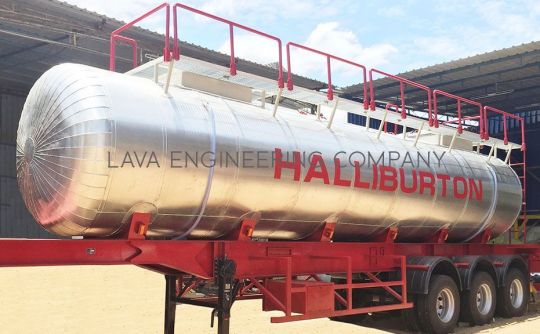
The Acid tanks are fitted or welded to the chassis of the trailer depending COG requirement. The design stimulation is carried out to ensure simultaneous braking and turning payload of the maximum load at stress points. The semi trailers are equipped with Formed beam chassis, landing Legs, ABS twin braking, Radial Tyres, Chemical spill arrangement & other accessories to meet clients with specific needs.
The Acid tank mounted on the trailer along with pipe lines and manifold are FRP lined, Rubber Lined, Lead Lined to carry Hazardous chemical liquids with Aluminum / Stainless Steel / GRP insulation to hold up to 200 Deg C.
DRY BULK TRANSPORT SEMI TRAILER
LAVA DRY BULK transport trailers are manufactured with Single and Multi-compartment tanks with variable compartment sizes are available from 50 BBL to 150 BBL. KNOW MORE
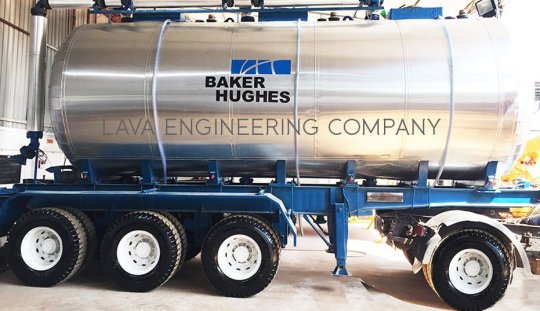
LAVA trailer Tanks are manufactured to customer specific designs of flanges, manholes, pipelines, outlets and an extensive range of variations and accessories that are available to suit Road conditions of particular country.
LAVA Semi Trailer tanks manufacturer, supplies tanks, which are equipped with emergency Trailer Roll-Over protection, Anti Slip Gruts, Collapsible Hand rails, Glass wool Insulation to accommodate heat up to 200 Deg C, Liquid Spill Collection area, Cassis Guard, ABS Braking, Triple Axle Suspension, Standard 2” Kingpin for universal acceptance and many more.
0 notes
Text
[Morocco World News is Moroccan Media]
29 Jun 23
In December 2020, a month after the end of the ceasefire between Morocco and the Polisario, then-President Donald Trump declared U.S. support for Morocco’s sovereignty over Western Sahara. The recognition contravened the United Nations’ position, which considers Western Sahara a “non-self governing territory,” a euphemism for a colony. In return for U.S. support on Western Sahara, Morocco joined the Abraham Accords, a series of diplomatic deals brokered by Trump and his son-in-law, Jared Kushner, that resulted in the United Arab Emirates, Sudan, Bahrain, and Morocco normalizing relations with Israel. Since then, Rabat has gone from having covert ties with Tel Aviv to becoming its open ally, and Israel has sold at least 150 drones to Morocco.[...]
Since 2020, the two countries have implemented a long series of economic and military agreements beyond the sale of drones. For the first time, Israeli troops from the elite Golani unit participated in Africa Lion, an 18-country joint military drill in Morocco, which completed on June 18. In 2021 and 2022, respectively, Gantz, Israel’s then-minister of defense, and then-Head of Israel Defense Forces Aviv Kochavi visited Morocco and signed several military deals, including a $500 million contract for the delivery of the Barak MX missile defense system to Rabat. Early this year, one of the Pentagon Discord leaks allegedly revealed that the system was scheduled to arrive in Morocco in mid-2023. Morocco is reportedly also in advanced negotiations to receive Israeli Merkava tanks. Rabat and Tel Aviv are also cooperating at an intelligence level. Morocco has widely been reported (and accused by other countries) as one of the most eager users of the Pegasus spyware developed by the Israeli NSO Group.
Meanwhile, economic cooperation is booming. According to U.N. data analyzed by The Intercept, in pre-Abraham 2019, trade between Israel and Morocco was at $70.7 million. In 2022, the figure reached $178.7 million, and Tel Aviv has declared it is targeting $500 million. From 2019 to 2022, exports from Israel to Morocco increased tenfold, from $3.8 million to $38.5 million. Western Sahara plays an important role in the love story between the two countries. In 2021 and 2022, two Israeli companies, Ratio Petroleum and NewMed Energy, obtained from Morocco rights to research and potentially exploit two separate offshore blocks in the Atlantic Ocean just off Western Sahara’s coastline. Moroccan local news also announced Israel’s Selina group would soon open a hotel in Dakhla. For Morocco, foreign investments in what it considers its “southern province” mean external recognition of its claims on the territory.[...]
In March last year, WSRW reported the first shipment of phosphate rock from Western Sahara to Israel. Erik Hagen, board member of WSRW, told The Intercept that the cargo was very small, and it is the only one they observed toward Israel. OCP, the Moroccan company extracting and exporting phosphate rock in Morocco and Western Sahara, hasn’t replied to a request for comment about the episode.
1 Jul 23
[Atalayar is Spanish Media]
As part of the US Senate debate on the National Defence Authorisation Act (NDAA) for fiscal year 2024, a law that supports the Armed Forces, modernises the Air Force and strengthens US national security, Arizona Democrat Senator Mark Kelly proposed integrating the Royal Moroccan Armed Forces (FAR) into military exercises led by the US Central Command (CENTCOM).
Part of this law states the need to assess threats in order to reduce those related to Iran's nuclear capabilities: 'It seeks to improve coordination between the United States and regional partners to counter the shared threat from Iran by supporting Morocco's integration into military exercises led by CENTCOM', as reported by media outlets such as Yabiladi and Morocco Latest News.
The operations carried out by this body seek to "improve coordination" between the US giant and "regional partners" in order to counter the threat posed by Iran to the whole. The US Central Command is one of nine unified security commands within the US Department of Defense and is responsible for US interests in 27 nations, operating in the Middle East, Central Asia and South Asia. [...]
Morocco is a permanent partner of the US Africa Command (AFRICOM) and an important player in the annual 'African Lion' exercises, in which a large number of African nations cooperate with the United States to promote defence and security against threats such as jihadist terrorism and organised crime. Now, it appears that Morocco may be close to joining the US military command in the Middle East (CENTCOM), and in addition to the scheduled AFRICOM exercises, Morocco may be called upon to participate in exercises organised by the US military in the Middle East region, thanks in part to a proposal by Senator Mark Kelly. [...]
With this possible entry into CENTCOM as the second African country after Egypt, Morocco, a great ally of the United States on the African continent, would thus strengthen its military and security cooperation with the US and, by extension, with other allied partners such as Israel. This privileged position gives Morocco the option of having access to an important market for weapons and technology produced by the US and Israel, which further strengthens the Moroccan military.
1 Jul 23
27 Jun 23
9 notes
·
View notes
Text
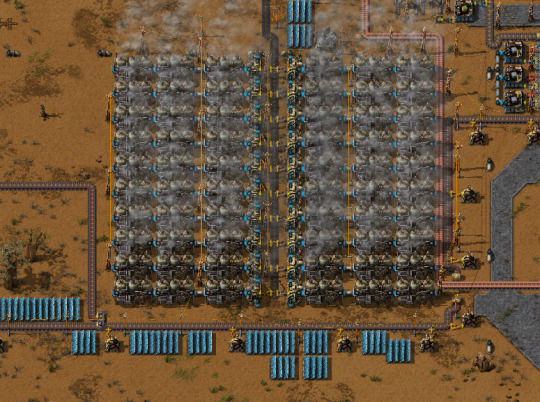
while i just got started producing solar panels and accumulators, i was watching my electricity graphs. as i dont have enough accumulators to cover the night deficit, the boilers kick in to full production. i realize i can just slightly stockpile steam in excess steam engines for more juice. after taking this screenshot i just added a row of tanks on either end so even more steam is stockpiled during the day. the ratio is 1 offshore pump can fill 20 boilers that provide steam to 40 steam engines, but that's full capacity. if i'm producing more steam during the day, that can be kept for night. luckily steam doesnt condense on it's own in factorio
2 notes
·
View notes
Text
Last time, I complained about how resource-intensive early nuclear power would be. However, more experienced Factorio users pointed out that I never cancelled out a crucial "200 seconds" figure in the calculations, which meant my estimates of uranium ore needed were orders of magnitude off.
Also, hooking up a consistent power plant mostly fixed my power problems. But since I want to scale up production soon, I decided to set up nuclear power anyways, so this won't happen again.
Nuclear reactors take a ton of resources, but they're all resources I had in buffer chests at various points. Most of them were in the starter base, but concrete is over in the stone base and sufficient amounts of copper (~1330 plates, by my calculations) are only found in the copper outpost.
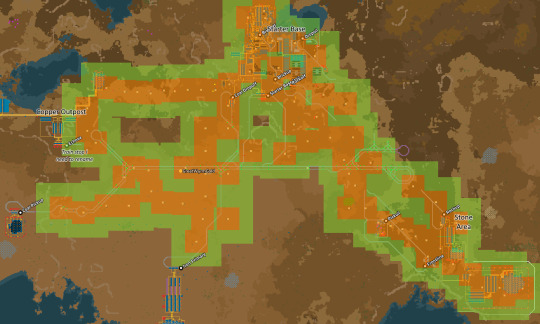
I had a lot of time running around; when not running around, I ordered the bot network to set up new rails to connect the coal mines to the starter base's power plant. Which took way more debugging than it should have, given how long it took me to realize the roboports' construction range was like three tiles short of the last bits of rail I needed to actually connect the coal mine to the rails leading to it...which was literally the only problem with the path...glad I understand rail signals at least...
In related news, I realize heavy oil cracking was nonfunctional due to one (1) missing pipe and it's backed up starter base oil production. But tonight isn't all stupid mistakes. I mined some uranium!
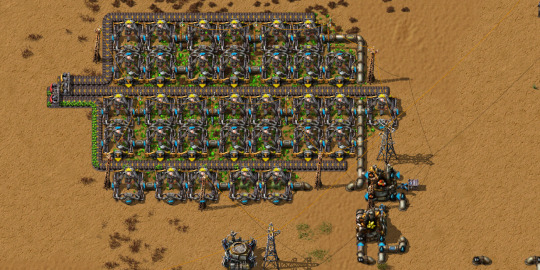
...emphasis on some.
Uranium is unique. It gets mined half as fast as other ores, you see, and mining it consumes sulfuric acid. In the lower right-hand corner, you can see a couple of chemical plants, one making sulfur and the other turning it into acid. This requires three ingredients: Water, petroleum gas, and iron. Luckily, they're all available just a bit to the southeast.
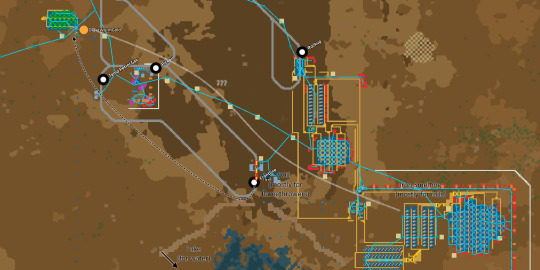
Water is easy; I just needed an offshore pump and a bunch of underground pipes. Also a fair number of aboveground pipes for corners and such.
A month ago, I set up a little oil processing station by my stone/rails/concrete outpost, which accidentally doubles as a defensive chokepoint. Back then, I mentioned that the petroleum gas would be used somewhere else in the factory, though at the time I thought that meant "in plastic production or something," but it's conveniently available to deal with a random resource requirement in this corner of the base.
That leaves iron, which is not a liquid. There are a few ways to get iron to the assembler; I considered several options before settling for a basic belt. Once I belted in the iron, I had basically everything I needed to set up Baby's First Nuclear Power Plant:
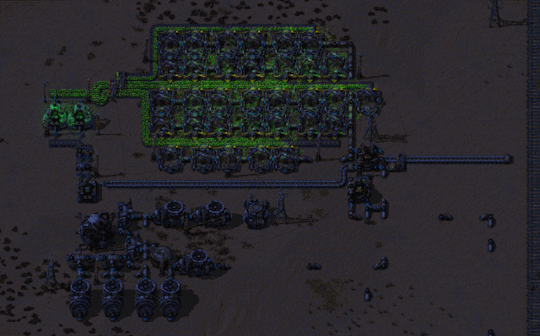
Straightforward enough, I think. Processing, sorting, and assembly turn uranium into fuel cells; the reactor turns cells into heat; the heat exchangers turn heat and water into high-temperature steam; the steam turbines turn steam into power.
The storage tank is a way to deal with an edge-case weakness of nuclear power. Basically, nuclear reactors (unlike coal boilers) keep burning their fuel no matter how much or little power is needed. Steam storage tanks mitigate this in two ways. First, they let the nuclear reactor "store" excess energy; the single tank can hold about a minute of unused power production. Second, with a little circuit network know-how, they can be used to estimate whether the nuclear reactor actually needs to run.
As far as I can tell, this design is only missing two things. First, it needs an inserter to remove expended fuel cells; I just forgot to set that up before taking the screenshot above. Second, it needs an inserter to put fresh cells in. That, I left out on purpose.
Somehow, setting up an extra coal plant, fixing coal supply, and leaving the factory mostly alone for a while fixed power. The steam engines and limited solar are providing more than enough power for the factory as it stands, which is a pleasant surprise!
That doesn't mean this was a waste, of course. I'm going to need more power once the main bus is running. But until then, I'm happy to let the centrifuges run. When I quit the game tonight, I had 74 U-238 and zero U-235. I'm happy to leave the machines alone to produce a few 235 before turning the reactor on.
Hopefully, the factory will grow soon.
3 notes
·
View notes
Text
ISRAEL REALTIME - "Connecting the World to Israel in Realtime"
Afternoon Nov 14
🔸DRONE ATTACK - ACCO… 9:55 AM. Intercepted offshore. Hezbollah from Lebanon.
🔸ROCKET STRIKE with Injuries, Ashkelon, 11:45 AM 2 men in their 30s moderate condition with head injuries. In addition, 2 anxiety victims were treated. Hamas from Gaza.
🔸MISSILE - EILAT… 12:44 PM. Smoke from a strike outside populated areas. Likely from Yemen.
🔸ROCKETS from Gaza… 1-1:20 PM, short range, Gaza surrounding towns.
◾️TULKARM (Samaria)… 14 hours of battle, gunfire, explosions, IDF drone airstrike, bulldozers, still in progress.
◾️HOSTAGE HORROR… In the area where the hostages are believed to have been held in Rants hospital in Gaza, a knife covered in blood was found. Forensic investigators of the Israel Police will examine it with the aim of gathering additional insights about the abductees who were held there. (Doron Kodesh, military correspondent)
◾️GAZA BATTLES… Heavy exchange of fire in the west of Beit Lahia, north Gaza. IDF has taken control of several Gaza government building.
◾️LEBANON BATTLES… anti-tank fire x 3, artillery returned. IDF attacking Eitaron in southern Lebanon.
22 notes
·
View notes